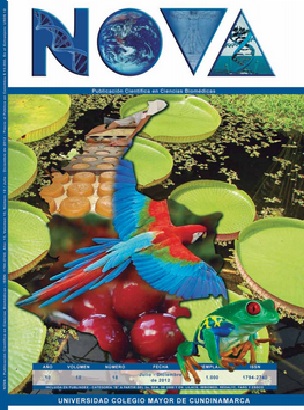El ataque de las bacterias: cómo prevenirlo sin morir en el intento.
The bacteria attack: how to prevent it and not die trying

NOVA por http://www.unicolmayor.edu.co/publicaciones/index.php/nova se distribuye bajo una Licencia Creative Commons Atribución-NoComercial-SinDerivar 4.0 Internacional.
Así mismo, los autores mantienen sus derechos de propiedad intelectual sobre los artículos.
Mostrar biografía de los autores
La diversidad de poblaciones microbianas que colonizan de forma permanente o transitoria la piel, depende de la topografía y fisiología de cada zona del cuerpo y cada área provee las condiciones necesarias para el desarrollo de microorganismos simbióticos, inofensivos e incluso beneficiosos, al mismo tiempo que regula las condiciones necesarias para evitar la colonización de agentes perjudiciales o patógenos. Alteraciones en este equilibrio dinámico, pueden causar infecciones locales o generalizadas por la diseminación de la flora normal de un sitio a otro.
El proceso evolutivo de la resistencia bacteriana ha sido corto y variable, condicionado en parte, por la presión selectiva ejercida frente a la terapia antimicrobiana. En respuesta, los microorganismos se han adaptado a las condiciones adversas mediante mecanismos de persistencia y resistencia que generan problemáticas a nivel epidemiológico, terapéutico y en la salud pública.
El fenómeno de la multiresistencia causa un impacto directo en la morbimortalidad e incrementa los costos en la atención en salud, por lo cual, además del correcto, apropiado y racional uso de los antimicrobianos, se requiere la prevención de las infecciones asociadas a la atención en salud mediante el control de la contaminación ambiental y el lavado de manos.
Finalmente, de las bacterias aprendemos que su interacción y organización comunitaria se constituyen en su “verdadera inteligencia” y podríamos morir en el intento de contener su ataque, si seguimos fortaleciendo las armas del “enemigo”.
Visitas del artículo 232 | Visitas PDF 111
Descargas
- Andersson, et al. Persistence of antibiotic resistance in bacterial populations. FEMS Microbiol Rev. 2011; 35(5):901-911.
- Garmendia, L. et al. Metagenomics and antibiotics. Clinical Microbiology and Infection. 2012; 18: 27–31.
- Clemente, J. et al. The Impact of the Gut Microbiota on Human Health: An Integrative View. Cell. 2012; 148 (6): 1258-1270.
- Costello, E. et al. Bacterial Community Variation in Human Body Habitats Across Space and Time. Science. 2009; 326 (5960): 1694-1697.
- Grice, E. et al. Topographical and temporal diversity of the human skin microbiome. Science 2009; 324:1190-1192.
- Grice, E. et al. The skin microbiome. Nature Reviews Microbiology. 2011; 9: 244-253.
- Peters, B. et al. Polymicrobial Interactions: Impact on Pathogenesis and Human Disease. Clin. Microbiol. 2012; 25 (1): 193-213.
- Iwase, et al. Staphylococcus epidermidis Esp inhibits Staphylococcus aureus biofilm formation and nasal colonization. Nature 2010; 456: 346-349.
- Park, H. Molecular Analysis of Colonized Bacteria in a Human Newborn Infant Gut. The Journal of Microbiology. 2005; 43 (4): 345-353.
- Dominguez, M. et al. Delivery mode shapes the acquisition and structure of the initial microbiota across multiple body habitats in newborns. Proc. Natl Acad. Sci. USA. 2010; 107:11971–11975.
- Reid, G. et al. Microbiota restoration: natural and supplemented recovery of human microbial communities. Nature Reviews Microbiology. 2011; 9: 27-38.
- Brandt, K. et al. Establishment of the bacterial fecal community during the first month of life in Brazilian newborns. Clinics. 2012; 67 (2): 113-123.
- Chia-Hui Y. et al. Host-microbial interactions and regulation of intestinal epithelial barrier function: From physiology to pathology. World J Gastrointest Pathophysiol. 2012; 3(1): 27–43.
- Szymańska, J. Dental bioaerosol as an occupational hazard in a dentist’s workplace. Annagric environmental medical. 2007; 14: 203-207.
- Pasquarella, C. et al. Microbialenvironmentalcontamination in Italian dental clinics: A multicenter study yielding recommendations for standardized sampling methods and threshold valuesScience of The Total Environment. Elservier Science. 2012; 420, 289–299.
- Zambrano, M. et al. Monitoreo bacteriológico de áreas clínicas odontológicas: estudio preliminar de un quirófano. Acta odontológica Venezolana. 2007; 45: 12-18.
- Kramer, A. et al. How long do nosocomial pathogens persist on inanimate surfaces? A systematic review. BMC Infectious Diseases. 2006; 6, 130–137.
- Álvarez, C. et al. Guías de práctica clínica para la prevención de infecciones intrahospitalarias asociadas al uso de dispositivos médicos. ACIN Capitulo Central. 2011; 3-96.
- Just, M. et al. Hygiene in Medical Technology. Springer Handbook of Medical Technology. 2012; Part A, 11-34.
- Szymańska, J. et al. Concentration and species composition of aerobic and facultatively anaerobic bacteria released to the air of a dental operation area before and after disinfection of dental unit waterlines. Annagric environ med. 2008; 2:301-307.
- Castiglia, P. et al. Italian multicenter study on infection hazards during dental practice: control of environmental microbial contamination in public dental surgeries resins used at graduation clinics. BMC PublicHealth. 2008; 8:187.
- Heinz-Michael, J. et al. Hygiene in Medical Technology. Springer Handbook of Medical Technology. 2012, Part A, 11-34.
- CDC. Boyce J. et al. Manual Guía para la Higiene de manos en Centros Sanitarios. 2002; 1: 3-100.
- Landers, T. et al. Patient-centered hand hygiene: The next step in infection prevention. American Journal of Infection Control.2012; 40 (4): S11-S17.
- Lins, L. et al. Prevalence of hepatitis A, B and C and use of infection control procedures by dental health care workers in Salvador, Bahia, Brazil. Gazeta Medica da Bahia. 2009; 79 (2):9-12.
- Chun, C. et al. The effectiveness of an air cleaner in controlling droplet/aerosol particle dispersion emitted from a patient’s mouth in the indoor environment of dental clinics. J R Soc
- Interface. 2010; 8 (58): 699-710.
- Buchter, A. et al. Development of a validated process for manual preparation of dental transmission instruments. Clinical Oral Investigation. 2011; 15(5): 605-608.
- Navarrete, J. et al. Evolución histórica de los antibióticos. En Cátedra abierta - Diario de campo. 2012; 4:77-90Nueva versión internacional. La Biblia. Deuteronomio 14:3-8.
- Lorenzo, Z. et al. History of Antibiotics. From Salvarsan to Cephalosporins. Journal of Investigative Surgery. 2012; 25 (2): 67-77.
- Clardy, J. et al. The natural history of antibiotics. Curr Biol. 2009; 19 (11): R437–R441.
- Álvarez, C. Uso prudente de antimicrobianos basado en el plan obligatorio de salud. Infectio. 2012; 16: 3-5.
- Cortes, J. .Para donde vamos en investigación? Infectio. 2012; 16 (S1): 3-4.
- Wright, G. et al. Antibiotics: A New Hope. Chemistry & Biology. 2012; 19 (1): 3-10.
- Brandl, K. et al. Vancomycin-resistant enterococci exploit antibiotic- induced innate immune deficits. Nature. 2008; 455: 804-07.
- Calvo, J. et al Mecanismos de acción de los antimicrobianos. Enfermedades Infecciosas y Microbiología Clínica. 2009; 27(1): 44-52.
- Poole, K. Bacterial stress responses as determinants of antimicrobial resistance J. Antimicrob. Chemother. 2012; 67 (7): 196-200.
- Bjarnsholt, T. et al. The role of quorum sensing in the pathogenicity of the cunning aggressor Pseudomonas aeruginosa.Analytical and bioanalytical chemistry. 2007; 409-414.
- Munoz, l. et al. Mecanismos de resistencia bacteriana. Colombia Genesis.2006; 1: 43-56.
- Wright et al. Molecular mechanisms of antibiotic resistance. Chem Commun (Camb). 2011; 47(14):4055-61.
- Andam, C. et al. Multilevel populations and the evolution of antibiotic resistance through horizontal gene transfer. FEMS Microbiology Reviews. 2011; 35: 756–767.
- Hall, R. et al. Mobile gene cassettes and integrons: moving antibiotic resistence genes in Gram negative bacterie. Origins, evolution, selection and spread. Ciba Foundation Symposium. 1997; 207:192-202.
- D´Costa, V. et al. Antibiotic resistance is ancient. Nature.2011; 477: 457–461.
- Poole, K. Efflux-Mediated Antimicrobial Resistance. Antibiotic Discovery and Development. Biomedical and Life Sciences. 2012; 3: 349-395.
- Nikaido, H. et al. Broad-specificity efflux pumps and their role in multidrug resistance of Gram-negative bacteria. FEMS Microbiology Reviews. 2012; 36: 340–363.
- Hoiby, N. et al. The clinical impact of bacterial biofilms. Int J Oral Sci.2011; 3:55-65.
- Phillips, P. et al. Molecular Mechanisms of Biofilm Infection: Biofilm Virulence Factors. Advances in Wound Care. 2012; 1(3): 109-114.
- O´Toole, G. Biofilm formation as microbial development. Annual Review of Microbiology 2000; 54: 49-79.
- Leung, E. et al. The WHO policy package to combat antimicrobial resistance. Bull World Health Organ, Genebra. 2011; 89 (5).
- Sosa, A. Containment of Antimicrobial Resistance in Developing Countries and Lessons LearnedBiomedical and Life Sciences. Antimicrobial Resistance in Developing Countries. 2010; 5: 447-461.
- Mosquera, M. No fortalezca su enemigo. El Tiempo Sección Salud. Mayo 27 de 2012. Pag. 20.
- ----------------------------------------------------------------------------
- DOI: http://dx.doi.org/10.22490/24629448.1012





